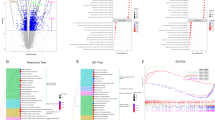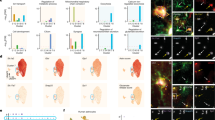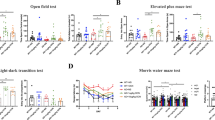Abstract
Neuronal differentiation from expanded human ventral mesencephalic neural precursor cells (NPCs) is very limited. Astrocytes are known to secrete neurotrophic factors, and so in order to enhance neuronal survival from NPCs, we tested the effect of regional astrocyte-conditioned medium (ACM) from the rat cortex, hippocampus and midbrain on this process. Human NPC's were expanded in FGF-2 before differentiation for 1 or 4 weeks in ACM. The results show that ACM from the hippocampus and midbrain increase the number of neurons from expanded human NPCs, an effect that was not observed with cortical ACM. In addition, both hippocampal and midbrain ACM increased the number and length of phosphorylated neurofilaments. MALDI-TOF analysis used to determine differences in media revealed that although all three regional ACMs had cystatin C, α-2 macroglobulin, extracellular matrix glycoprotein and vimentin, only hippocampal and midbrain ACM also contained clusterin, which when immunodepleted from midbrain ACM eliminated the observed effects on neuronal differentiation. Furthermore, clusterin is a highly glycosylated protein that has no effect on cell proliferation but decreases apoptotic nuclei and causes a sustained increase in phosphorylated extracellular signal-regulated kinase, implicating its role in cell survival and differentiation. These findings further reveal differential effects of regional astrocytes on NPC behavior and identify clusterin as an important mediator of NPC-derived neuronal survival and differentiation.
Similar content being viewed by others
Log in or create a free account to read this content
Gain free access to this article, as well as selected content from this journal and more on nature.com
or
Abbreviations
- ACM:
-
astrocyte-conditioned medium
- pERK:
-
phosphorylated extracellular signal-regulated kinase
- NPCs:
-
neural precursor cells
References
Barres BA . The mystery and magic of glia: a perspective on their roles in health and Disease. Neuron 2008; 60: 430–440.
Hewett JA . Determinants of regional and local diversity within the astroglial lineage of the normal central nervous system. J Neurochem 2009; 110: 1717–1736.
Takeshima T, Shimoda K, Sauve Y, Commissiong JW . Astrocyte dependent and independent phases of the development and survival of rat embryonic day 14 mesencephalic, dopaminergic neurons in culture. Neuroscience 1994; 60: 809–823.
Suhonen JO, Peterson DA, Ray J, Gage FG . Differentiation of adult hippocampus derived progenitors into olfactory neurons in vivo. Nature 1996; 383: 624–627.
Gage FH . Mammalian neural stem cells. Science 2000; 287: 1433–1438.
Svendsen CN, ter Borg MG, Armstrong RJ, Rosser AE, Chandran S, Ostenfeld T et al. A new method for the rapid and long term growth of human neural precursor cells. J Neurosci Meth 1998; 85: 141–152.
Ostenfeld T, Joly E, Tai YT, Peters A, Caldwell M, Jauniaux E et al. Regional specification of rodent and human neurospheres. Dev Brain Res 2002; 134: 43–55.
Song H, Stevens CF, Gage FH . Astroglia induce neurogenesis from adult neural stem cell. Nature 2002; 417: 39–44.
Lafon-Cazal M, Adjali O, Galeotti N, Poncet J, Jouin P, Homburger V et al. Proteomic analysis of astrocytic secretion in the mouse. J Biol Chem 2003; 278: 24438–24448.
Lubetzki C, Demerens C, Anglade P, Villarroya H, Frankfurter A, Lee VM et al. Even in culture, oligodendrocytes myelinate solely axons. Proc Natl Acad Sci USA 1993; 90: 6820–6824.
Carden MJ, Trojanowski JQ, Schlaepfer WW, Lee VM . To-stage expression of neurofilament polypeptides during rat neurogenesis with early establishment of adult phosphorylation patterns. J Neurosci 1987; 7: 3489–3504.
Wilkin GP, Marriott DR, Cholewinski AJ . Astrocyte hetrogeneity. TiNS 1990; 13: 48–57.
Joannides A, Gaughwin P, Schwiening C, Majed H, Sterling J, Compston A et al. Efficient generation of neural precursors from adult human skin: astrocytes promote neurogenesis from skin-derived stem cells. Lancet 2004; 364: 172–178.
Nakayama T, Momoki-Soga T, Inoue N . Astrocyte derived factors instruct differentiation of embryonic stem cells into neurons. Neurosci Res 2003; 46: 241–249.
Yasuhura O, Hani K, Ohkubo I, Sasaki M, McGeer PL, Kimura H . Expression of cystatin C in rat, monkey and human brains. Brain Res 1993; 628: 85–92.
Taupin P, Ray J, Fischer WH, Suhr ST, Hakansson K, Grubb A . Gage FH FGF-2-responsive neural stem cell proliferation requires CCg, a novel autocrine/paracrine cofactor. Neuron 2000; 28: 385–397.
Olsson T, Nygren J, Håkansson K, Lundblad C, Grubb A, Smith ML et al. Gene deletion of cystatin C aggravates brain damage following focal ischemia but mitigates the neuronal injury after global ischemia in the mouse. Neuroscience 2004; 128: 65–71.
Xu L, Sheng J, Tang Z, Wu X, Yu Y, Guo H et al. Cystatin C prevents degeneration of rat nigral dopaminergic neurons: in vitro and in vivo studies. Neurobiol Dis 2005; 18: 152–165.
Dziegielewska KM, Saunders NR, Schejter EJ, Zakut H, Zevin-Sonkin D, Zisling R et al. Synthesis of plasma proteins in fetal, adult, and neoplastic human brain tissue. Dev Biol 1986; 115: 93–104.
Gebicke-Haerter PJ, Bauer J, Brenner A, Gerok W . Alpha 2-macroglobulin synthesis in an astrocyte subpopulation. J Neurochem 1987; 49: 1139–1145.
Lin CH, Cheng FC, Lu YZ, Chu LF, Wang CH, Hsueh CM . Protection of ischemic brain cells is dependent on astrocyte-derived growth factors and their receptors. Exp Neurol 2006; 201: 225–233.
Caldwell MA, He X, Wilkie N, Pollack S, Marshall G, Wafford KA et al. Growth factors regulate the survival and fate of cells derived from human neurospheres. Nat Biotechnol 2001; 19: 475–479.
Lee PG, Koo PH . Rat alpha1-macroglobulin enhances nerve growth factor-promoted neurite outgrowth, TrkA phosphorylation, and gene expression of pheochromocytoma PC12 cells. J Neurochem 2000; 74: 81–91.
Rosenberg ME, Silkensen J . Clusterin: physiologic and pathological considerations. Int J Biochem 1995; 27: 633–645.
Pasinetti GM, Johnson SA, Oda T, Rozovsky I, Finch CE . Clusterin (SPG-2): a multifunctional glycoprotein with regional expression in astrocytes and neurons of the adult rat brain. J Comp Neurol 1994; 339: 387–400.
Nishida E, Gotoh Y . The MAP kinase cascade is essential for diverse signal transduction rathways. TiBS 1993; 18: 128–131.
Saura J, Petegnief V, Wu X, Liang Y, Paul SM . Microglial apolipoprotein E and astoglial apolipoprotein J expression in vitro: opposite effects of lipopolysaccharide. J Neurochem 2003; 85: 1455–1467.
May PC, Finch CE . Sulfated glycoprotein2: new relationship of this new multifunctional protein to Neurodegeneration. Trends Neurosci 1992; 15: 391–396.
Giannakopoulos P, Kövari E, French LE, Viard I, Hof PR, Bouras C . Possible neuroprotective role of clusterin in Alzheimer's disease: a quantitative immunocytochemical study. Acta Neuropathol 1998; 95: 387–394.
Harold D, Abraham R, Hollingworth P, Sims R, Gerrish A, Hamshere ML et al. Genome wide association study identifies variants at CLU and PICALM associated with Alzheimers disease. Nat Genet 2009; 41: 1088–1093.
Lambert JC, Heath S, Even G, Campion D, Sleegers K, Hiltunen M et al. Genome wide association study identifies variants at CLU and CR1 associated with Alzheimers disease. Nat Genet 2009; 41: 1094–1099.
Nuutinen T, Suuronen T, Kauppinen A, Salminen A . Clusterin: a forgotten player in Alzheimers disease. Brain Res Rev 2009; 61: 89–104.
Harr SD, Uint L, Hollister R, Hyman BT, Mendez AJ . Brain expression of apolipoprotein E, J and A-I in Alzheimers disease. J Neurochem 1996; 66: 2429–2435.
McLaughlin L, Zhu G, Mistry M, Ley-Ebert C, Stuart WD, Florio CJ et al. Apolipoprotein J/clusterin limits the severity of murine autoimmune myocarditis. J Clin invest 2000; 106: 1105–1113.
Wehrli P, Charnay Y, Vallet P, Zhu G, Harmony J, Aronow B et al. Inhibition of post-ischemic brain injury by clusterin overexpression. Nat Med 2001; 7: 977–979.
Han BH, DeMattos RB, Dugan LL, Kim-Han JS, Brendza RP, Fryer JD et al. Clusterin contributes to caspase-3-independent brain injury following neonatal hypoxia-ischemia. Nat Med 2001; 7: 338–343.
Choi BM, Pae HO, Jang SI, Kim YM, Chung HT . Nitric oxide as a pro-apoptotic as well as anti-apoptotic modulator. J Biochem Mol Biol 2002; 35: 116–126.
Piret JP, Mottet D, Raes M, Michiels C . Is HIF-1alpha a pro- or an anti-apoptotic protein? Biochem Pharmacol 2002; 64: 889–892.
McCarthy KD, deVellis J . Preparation of separate astriglial and oligodendroglial cell cultures from rat cerebral tissue. J Cell Biol 1980; 85: 890–902.
Stephens E, Sugars J, Maslen SL, Williams DH, Packman LC, Ellar DJ . The N-linked oligosaccharides of aminopeptidase N from Manduca sexta: site localization and identification of novel N-glycan structures. Eur J Biochem 2004; 271: 4241–4258.
Acknowledgements
This work was funded by an MRC Studentship (SAS), University of Bristol Studentship (OC-L) and the Royal Society and Parkinsons Disease Society (MAC). RAB and PT receive support from the NIHR grant of a Biomedical research centre to the University of Cambridge and Addenbrooke's Hospital, and the MRC for fetal tissue collection. CMK and AER receive support from the MRC (UK) and Wales Office of Research and Development for human fetal tissue collection. The INCELL analyser was funded by the Wellcome Trust Equipment Grant (078407) to Craig A McArdle, University of Bristol.
Author information
Authors and Affiliations
Corresponding author
Ethics declarations
Competing interests
The authors declare no conflict of interest.
Additional information
Edited by RA Knight
Supplementary Information accompanies the paper on Cell Death and Differentiation website
Rights and permissions
About this article
Cite this article
Cordero-Llana, O., Scott, S., Maslen, S. et al. Clusterin secreted by astrocytes enhances neuronal differentiation from human neural precursor cells. Cell Death Differ 18, 907–913 (2011). https://doi.org/10.1038/cdd.2010.169
Received:
Revised:
Accepted:
Published:
Issue date:
DOI: https://doi.org/10.1038/cdd.2010.169
Keywords
This article is cited by
-
Exercise mimetics: a novel strategy to combat neuroinflammation and Alzheimer’s disease
Journal of Neuroinflammation (2024)
-
Clusterin is a Potential Therapeutic Target in Alzheimer’s Disease
Molecular Neurobiology (2023)
-
Dynamic changes of CSF clusterin levels across the Alzheimer’s disease continuum
BMC Neurology (2022)
-
New fluid biomarkers tracking non-amyloid-β and non-tau pathology in Alzheimer’s disease
Experimental & Molecular Medicine (2020)
-
Safety and efficacy of human embryonic stem cell-derived astrocytes following intrathecal transplantation in SOD1G93A and NSG animal models
Stem Cell Research & Therapy (2018)



